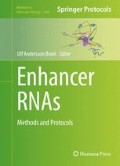Abstract
The development of High Throughput Sequencing (HTS) for RNA profiling (RNA-seq) has shed light on the diversity of transcriptomes. While RNA-seq is becoming a de facto standard for monitoring the population of expressed transcripts in a given condition at a specific time, processing the huge amount of data it generates requires dedicated bioinformatics programs. Here, we describe a standard bioinformatics protocol using state-of-the-art tools, the STAR mapper to align reads onto a reference genome, Cufflinks to reconstruct the transcriptome, and RSEM to quantify expression levels of genes and transcripts. We present the workflow using human transcriptome sequencing data from two biological replicates of the K562 cell line produced as part of the ENCODE3 project.
The original version of this chapter was revised. An erratum to this chapter can be found at DOI 10.1007/978-1-4939-4035-6_17
An erratum to this chapter can be found at http://dx.doi.org/10.1007/978-1-4939-4035-6_17
Access this chapter
Tax calculation will be finalised at checkout
Purchases are for personal use only
References
Wang Z, Gerstein M, Snyder M (2009) RNA-seq: a revolutionary tool for transcriptomics. Nature 10:57–63
Djebali S, Davis CA, Merkel A et al (2012) Landscape of transcription in human cells. Nature 488:101–108
Dobin A, Davis CA, Schlesinger F et al (2012) STAR: ultrafast universal RNA-seq aligner. Bioinformatics 29:15–21
Trapnell C, Williams BA, Pertea G et al (2010) Transcript assembly and quantification by RNA-seq reveals unannotated transcripts and isoform switching during cell differentiation. Nat Biotechnol 28:511–515
Li B, Ruotti V, Stewart RM et al (2010) RNA-seq gene expression estimation with read mapping uncertainty. Bioinformatics 26:493–500
T.E.P. Consortium, T.E.P. Consortium, O.C. Data Analysis Coordination et al (2013) An integrated encyclopedia of DNA elements in the human genome. Nature 488:57–74
Martens JHA, Stunnenberg HG (2013) BLUEPRINT: mapping human blood cell epigenomes. Haematologica 98:1487–1489
Steijger T, Abril JF, Engström PG et al (2013) Assessment of transcript reconstruction methods for RNA-seq. Nat Methods 10:1177–1184
Engström PG, Steijger T, Sipos B et al (2013) Systematic evaluation of spliced alignment programs for RNA-seq data. Nat Methods 10:1185–1191
Roberts A, Goff L, Pertea G et al (2012) Differential gene and transcript expression analysis of RNA-seq experiments with TopHat and Cufflinks. Nat Protoc 7:562–578
Marco-Sola S, Sammeth M, Guigó R et al (2012) The GEM mapper: fast, accurate and versatile alignment by filtration. Nat Methods 9:1185–1188
Pertea M, Pertea GM, Antonescu CM et al (2015) StringTie enables improved reconstruction of a transcriptome from RNA-seq reads. Nat Biotechnol 33:290–295
Montgomery SB, Sammeth M, Gutierrez-Arcelus M et al (2010) Transcriptome genetics using second generation sequencing in a Caucasian population. Nature 464:773–777
Roberts A, Pachter L (2013) Streaming fragment assignment for real-time analysis of sequencing experiments. Nat Methods 10:71–73
Patro R, Mount SM, Kingsford C (2014) Sailfish enables alignment-free isoform quantification from RNA-seq reads using lightweight algorithms. Nat Biotechnol 32:462–464
Haas BJ, Papanicolaou A, Yassour M et al (2013) De novo transcript sequence reconstruction from RNA-seq using the Trinity platform for reference generation and analysis. Nat Protoc 8:1494–1512
Sacomoto GAT, Kielbassa J, Chikhi R et al (2012) KISSPLICE: de-novo calling alternative splicing events from RNA-seq data. BMC Bioinformatics 13(Suppl 6):S5
Rosenbloom KR, Sloan CA, Malladi VS et al (2013) ENCODE data in the UCSC Genome Browser: year 5 update. Nucleic Acids Res 41:D56–D63
Harrow J, Frankish A, Gonzalez JM et al (2012) GENCODE: the reference human genome annotation for The ENCODE Project. Genome Res 22:1760–1774
Derrien T, Johnson R, Bussotti G et al (2012) The GENCODE v7 catalog of human long noncoding RNAs: analysis of their gene structure, evolution, and expression. Genome Res 22:1775–1789
Pei B, Sisu C, Frankish A et al (2012) The GENCODE pseudogene resource. Genome Biol 13:R51
Li H, Handsaker B, Wysoker A et al (2009) The sequence alignment/map format and SAMtools. Bioinformatics 25:2078–2079
Cunningham F, Amode MR, Barrell D et al (2015) Ensembl 2015. Nucleic Acids Res 43:D662–D669
Knowles DG, Röder M, Merkel A et al (2013) Grape RNA-seq analysis pipeline environment. Bioinformatics 29:614–621
Jiang L, Schlesinger F, Davis CA et al (2011) Synthetic spike-in standards for RNA-seq experiments. Genome Res 21:1543–1551
Risso D, Ngai J, Speed TP et al (2014) Normalization of RNA-seq data using factor analysis of control genes or samples. Nat Biotechnol 32:896–902
Author information
Authors and Affiliations
Corresponding authors
Editor information
Editors and Affiliations
Rights and permissions
Copyright information
© 2017 Springer Science+Business Media New York
About this protocol
Cite this protocol
Djebali, S., Wucher, V., Foissac, S., Hitte, C., Corre, E., Derrien, T. (2017). Bioinformatics Pipeline for Transcriptome Sequencing Analysis. In: Ørom, U. (eds) Enhancer RNAs. Methods in Molecular Biology, vol 1468. Humana Press, New York, NY. https://doi.org/10.1007/978-1-4939-4035-6_14
Download citation
DOI: https://doi.org/10.1007/978-1-4939-4035-6_14
Published:
Publisher Name: Humana Press, New York, NY
Print ISBN: 978-1-4939-4033-2
Online ISBN: 978-1-4939-4035-6
eBook Packages: Springer Protocols

